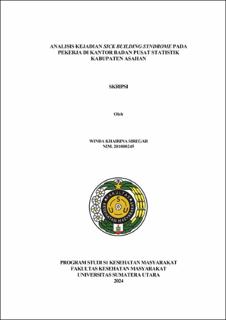Analisis Kejadian Sick Building Syndrome pada Pekerja di Kantor Badan Pusat Statistik Kabupaten Asahan
Analysis of The Incidence of Sick Building Syndrome in Workers at Central Bureau of Statistics Asahan Regency

Date
2024Author
Siregar, Winda Khairina
Advisor(s)
Marsaulina, Irnawati
Metadata
Show full item recordAbstract
The growth of high-rise building construction has progressed significantly,
Indonesia's population density encourages office designs that utilize limited
space, this has a negative impact on indoor air quality, one of the diseases
resulting from unhealthy environmental conditions is known as sick building
syndrome. This study aims to analyze the incidence of sick building syndrome in
workers at Central Bureau of statistics Asahan Regency. This type of research is
quantitative research with descriptive analytic method. The study design used was
cross sectional. Sampling using purposive sampling with inclusion and exclusion
criteria totaling 28 people. Data collection with a questionnaire to determine the
characteristics of respondents, use of materials in the building, and SBS symptoms
experienced and observation sheets to measure physical factors, namely
temperature and humidity, then analyzed by chi-square statistical test. The results
showed that out of 28 employees, 16 employees (57%) experienced SBS and 12
employees (43%) did not experience SBS. Symptoms of SBS experienced by 20%
of BPS employees were headache, itchy eyes, watery eyes, itchy nose, dry skin,
lethargy or fatigue, loss of concentration, and drowsiness. Statistical test results
showed that there was a significant relationship between temperature (p value =
0.019) and humidity (p value = 0.039) with the incidence of SBS. There was no
significant relationship between age (p value = 0.687), gender (p value = 0.703),
tenure (p value = 0.673), length of work (p value = 1), smoking status (p value =
1), history of allergy/atopy (p value = 0.673), wall wallpaper (p value = 0.613),
and copier/printer (p value = 0.184) with the incidence of SBS. It is recommended
to conduct routine monitoring of temperature and humidity in the workspace to
ensure both parameters are within the recommended range.
Collections
- Undergraduate Theses [3365]
